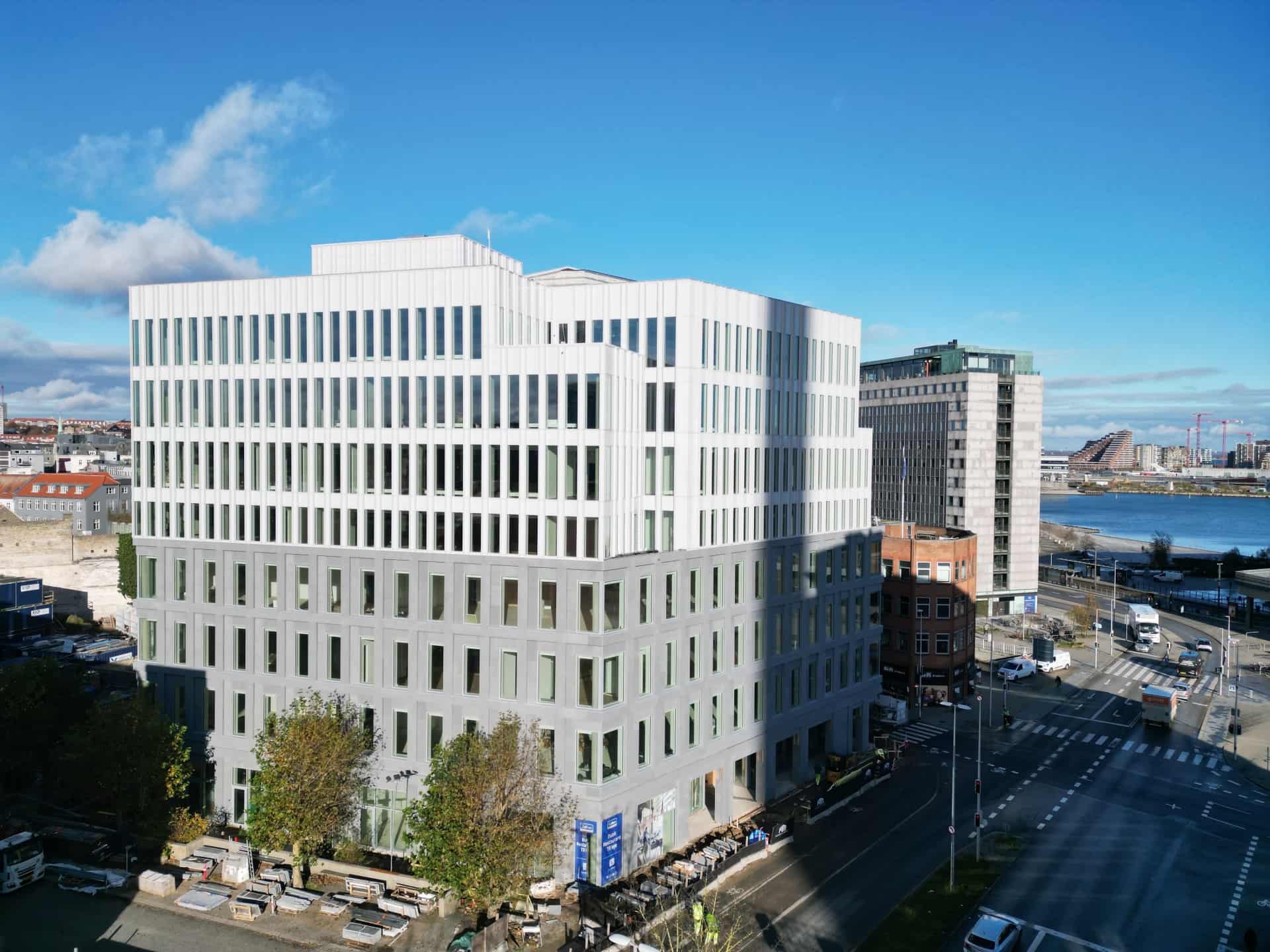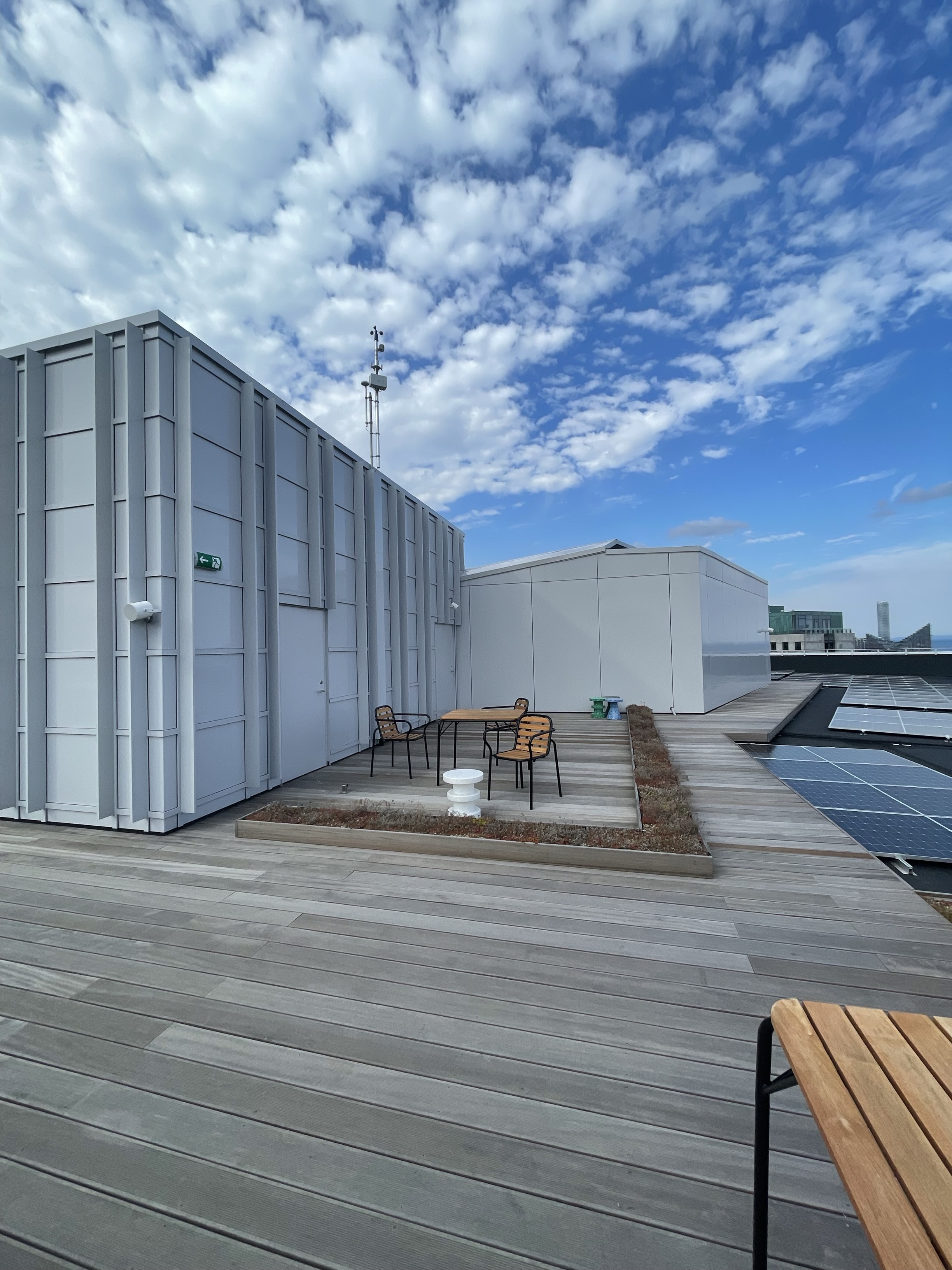Building Integrated Carbon Capture technology
Regenerative Building Pilot at Europaplads
Creating negative emissions with onsite Building HVAC-Integrated CO2 Capture technology at Danica Pension’s building in Aarhus, Denmark
This project has began in Danica Pension‘s building at Europaplads 6-8, Dk-8000 Aarhus C, Denmark, where the world’s first facility is capturing CO2 from the ventilation air in an office building. The target is to make emission truly net zero and make the building potentially net negative. This is done in collaboration with the engineering firm Søren Jensen, which is a tenant in the property. The project is praised by the Novo Nordisk Foundation’s CO2 research center at Aarhus University and aims to show how the real estate industry can have a positive climate effect and contribute to climate-neutral societies.
Soletair Power’s specially designed filters collect CO2 from the ventilation air in the property, after which it is stored in tanks. After this, the captured CO2 can , for example, be stored underground, used for the production of green hydrogen from Power-to-X or to produce building materials such as concrete, which both store CO2 and have a significantly lower climate footprint than traditional building materials.
The project is part of Danica Ejendomme’s multi-pronged efforts to reduce the climate footprint and contribute to society’s climate goals. And since properties will always have a certain climate impact, it is necessary to explore and promote new technologies that have a compensating climate effect.
Read more here:
https://danicapension.dk/om-danica-pension/presse/nyheder/privat/danica-pension-etablerer-verdens-foerste-anlaeg-for-co2-fangst-i-en-kontorbygning
Soletair Power’s Solution
Soletair Power partnered with Soren Jensen, to install a Building Integrated Carbon Capture (BICC) unit at Danica Pension’s building in Aarhus, Denmark.
Benefits
Soletair Power’s CO2 capture solution offers a multitude of benefits here:
- Energy Efficiency: Dynamic ventilation control optimizes energy consumption within the existing HVAC system.
- Sustainable Solutions: Helps the tenant companies to reduce their Scope 3 emissions and align with environmental goals by reducing net carbon footprint of the building.
- Modular Design & Scalability: Modular design allows for easy installation and integration with existing building automation systems. The captured CO2 can be utilized in various sustainable applications.
Technical Specifications of the Unit:
- CO2 Capture Capacity: 15 tons/year* (average 20 kg/day)
- CO2 Purity: > 98 %
- Impurities:
- Pressure: Up to 70 bar
- Sorbent Filters: Proprietary amine-functionalized solid sorbents that adsorb CO2 selectively.
- Regeneration Process: Temperature Vacuum Swing Adsorption (TVSA)
- Integration: Compatible with IoT sensors and building automation systems.
- Size: Minimum HVAC room size 4.5 m x 8.2 m x 3.5 m
- Construction begins: July 2024
- Facility operational: 2026
This Direct Air Capture (DAC) plant have two separate systems. These systems are in different locations:
1) DAC plant (DAC plant) in top floor
2) High-pressure compressor room (HPC room) in the ground floor
* Production rate of the system depends on input air conditions like temperature, moisture, and CO2 content of the input air. Hence the average production rate is promised to be 50 kg/day over the year. With lower temperatures production is higher and on the contrary higher temperature leads to a lower production rate. 50 kg/day capture rate is expected when the input air temperature: +15 °C, moisture level: +40 %RH, and air CO2 content: +400 ppm.
HVAC outlet delivers CO2 to system
The building’s HVAC system pulls in air and ventilates it. The polluted air exiting from the building is delivered to the carbon capture system.
Sorbent captures CO2
The air is pushed through the proprietarysorbents. They selectively adsorb carbon dioxide. When the filter is saturated, the machine is closed and regenerated via vacuum & heating to collect the captured CO2.
Sorage & Utilization
The captured CO2 is stored in a separate container near or inside the building, and it can later be supplied for storage or utilization.
Facts
- The plant is produced by Finnish Soletair Power, which is a world leader in the capture, storage and use of CO2 from the air (Direct Air Capture) via ventilation systems in buildings.
- The life cycle analysis of the facility’s climate effect estimates that 5 kilos of CO2 per m2 are captured, which corresponds to approximately 15 tonnes of CO2 per year in the 3,000 m2 lease.
- In Denmark, there are approximately 87 million m2 of commercial properties and 88 million m2 of residential properties (Source). This means that if similar facilities were installed in all properties, there is a full technical potential to capture approximately 8.5 million tonnes of CO2 per year.
- The property is DGNB Gold certified.
- The property contains recycled and reused materials such as ventilation ducts, cable trays, radiators and lighting fixtures that come from another Danica-owned office property. The initiative has been awarded the award “The Sustainable Element – The Solution Award” from Building Green for making a sustainable difference in the construction industry.
- The project is part of Danica Ejendomme’s efforts to reduce the climate footprint of the Danish property portfolio and contribute to society’s climate goals.
Looking for collaboration?
Call us: +358 40 544 5646
Tuotantokatu 2
53850 Lappeenranta
Finland
Interested to work with us? Send your resume.
Make your building capture CO2 from air
Contact us


